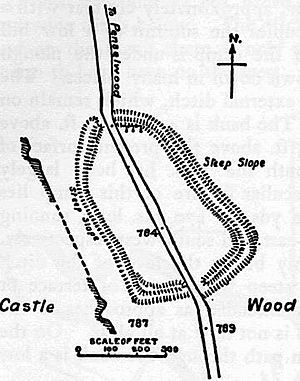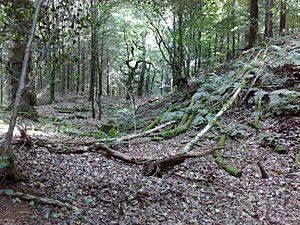Kenwalch's Castle facts for kids
Quick facts for kids Kenwalch's Castle |
|
|---|---|

Plan of the earthworks at Kenwalch's Castle
|
|
| Location | Penselwood, Somerset, England |
| Area | 1.6 hectares (4.0 acres) |
| Built | Iron Age |
| Reference no. | 202653 |
| Lua error in Module:Location_map at line 420: attempt to index field 'wikibase' (a nil value). | |
Kenwalch's Castle is an ancient site in England. It is probably an Iron Age hill fort. This means it was a fortified settlement built a very long time ago, around 800 BC to AD 100. It might have later been used as a Roman fortress.
The site is near Penselwood, Somerset, England. It is about 6.6 kilometers (4.1 miles) east-southeast of Bruton. Kenwalch's Castle is a Scheduled Ancient Monument. This means it is a very important historical site that is protected by law. It is believed to be named after Cenwalh of Wessex, an old English king.
The site sits right on the border between Somerset and Wiltshire. It is hidden inside Castle Wood. This wood covers the old defenses and the inside area of the fort. The whole area is about 1.6 hectares (4 acres) in size.
Exploring the Castle's Defenses
Kenwalch's Castle has a single rampart and a ditch. These are like big earth walls and trenches that were built for protection. They are still very well preserved in some places today.
The earthwork bank, or wall, can be up to 2 meters (6.6 feet) high. It has a ditch next to it that is also about 2 meters (6.6 feet) deep in some parts. A road that goes north from Penselwood village crosses through the hill fort. This road probably goes through the original entrances to the fort.
A Place in History
Kenwalch's Castle is thought to be the place where the Battle of Peonnum happened. This was an important battle in early English history. It took place around the year 658 AD.
What is a Hill Fort?
Hill forts are ancient settlements that were built on hills. They were common in Britain during the Late Bronze Age and Early Iron Age. This was roughly from 1000 BC onwards. People built them for different reasons.
One main reason was for protection. They offered a safe place for communities during times of conflict. They also served as important centers for trade and gatherings. People might have lived inside them, or used them as a refuge when danger appeared.
The use of iron became more common during this time. This led to changes in how people lived and traded. Hill forts became important places for these new communities. They were strongholds that could be defended if there were problems between groups.


